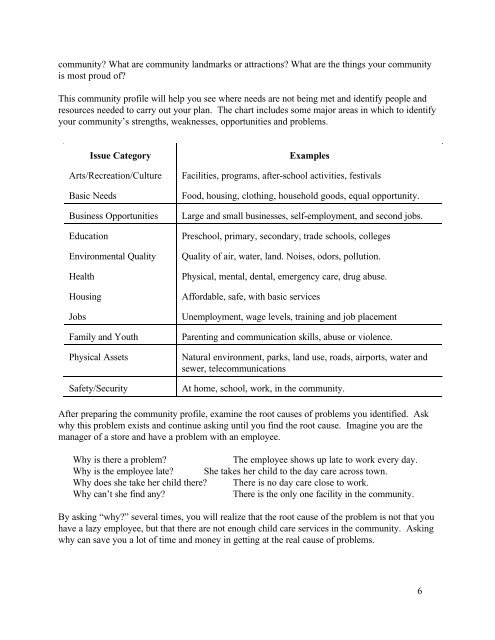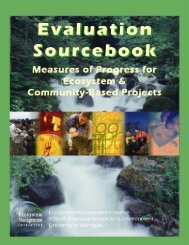A Guide to Strategic Planning for Rural Communities - USDA Rural ...
A Guide to Strategic Planning for Rural Communities - USDA Rural ...
A Guide to Strategic Planning for Rural Communities - USDA Rural ...
You also want an ePaper? Increase the reach of your titles
YUMPU automatically turns print PDFs into web optimized ePapers that Google loves.
community? What are community landmarks or attractions? What are the things your community<br />
is most proud of?<br />
This community profile will help you see where needs are not being met and identify people and<br />
resources needed <strong>to</strong> carry out your plan. The chart includes some major areas in which <strong>to</strong> identify<br />
your community’s strengths, weaknesses, opportunities and problems.<br />
Issue Category<br />
Arts/Recreation/Culture<br />
Basic Needs<br />
Business Opportunities<br />
Education<br />
Environmental Quality<br />
Health<br />
Housing<br />
Jobs<br />
Family and Youth<br />
Physical Assets<br />
Safety/Security<br />
Examples<br />
Facilities, programs, after-school activities, festivals<br />
Food, housing, clothing, household goods, equal opportunity.<br />
Large and small businesses, self-employment, and second jobs.<br />
Preschool, primary, secondary, trade schools, colleges<br />
Quality of air, water, land. Noises, odors, pollution.<br />
Physical, mental, dental, emergency care, drug abuse.<br />
Af<strong>for</strong>dable, safe, with basic services<br />
Unemployment, wage levels, training and job placement<br />
Parenting and communication skills, abuse or violence.<br />
Natural environment, parks, land use, roads, airports, water and<br />
sewer, telecommunications<br />
At home, school, work, in the community.<br />
After preparing the community profile, examine the root causes of problems you identified. Ask<br />
why this problem exists and continue asking until you find the root cause. Imagine you are the<br />
manager of a s<strong>to</strong>re and have a problem with an employee.<br />
Why is there a problem?<br />
The employee shows up late <strong>to</strong> work every day.<br />
Why is the employee late? She takes her child <strong>to</strong> the day care across <strong>to</strong>wn.<br />
Why does she take her child there? There is no day care close <strong>to</strong> work.<br />
Why can’t she find any?<br />
There is the only one facility in the community.<br />
By asking “why?” several times, you will realize that the root cause of the problem is not that you<br />
have a lazy employee, but that there are not enough child care services in the community. Asking<br />
why can save you a lot of time and money in getting at the real cause of problems.<br />
6






